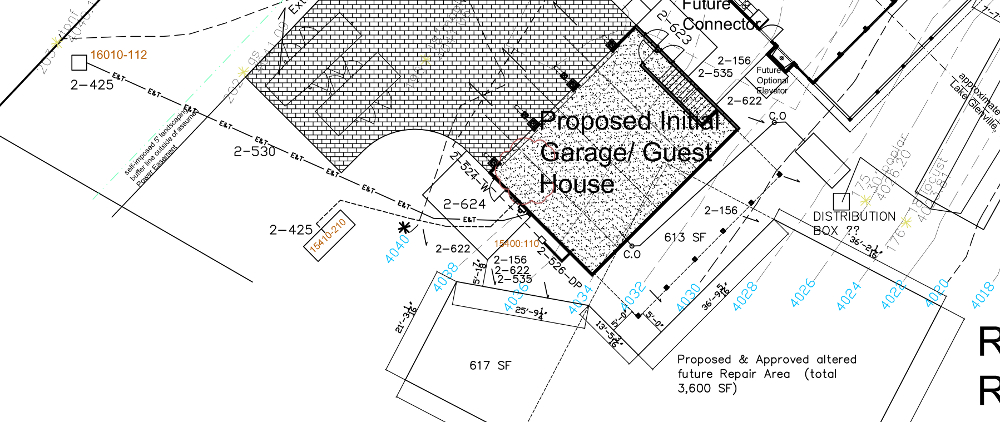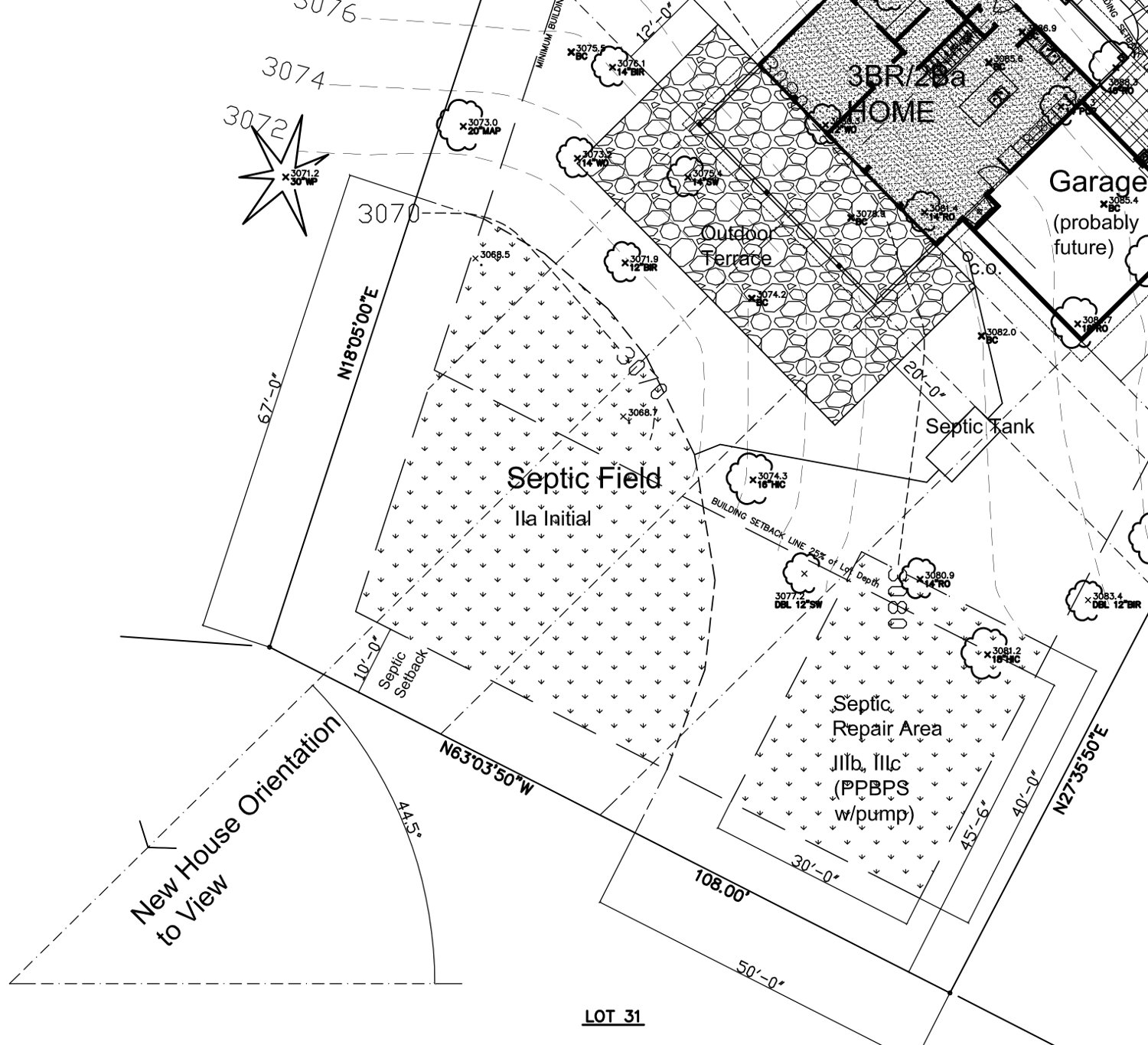Some people are under the impression that when they have a house designed and built, that they do not need a survey. They are sorely mistaken. No matter how large your property is, you need a survey. Read on to understand why…

Click on the image above to see the Architect Site Consultation Service Page.
Let’s say you happen to own 10 acres, or 50 acres or 200 acres. You believe that because your land is so large, that you won’t possibly be required to document anything regarding your land. Well, that’s just not the case. Here’s why:
1. BUILDING SETBACKS
Your local County (or municipal) Planning & Zoning Department (and possibly your HOA (HomeOwners’ Association) if there is one) almost always has required distances from your property line that you must be inboard from, otherwise you are in violation of County/City land planning regulations. If you build too close to your lot lines (even if allowed to by the County), you could also be in violation of the IRC (International Building Code) and your State’s commercial building code with regard to fire rated walls on neighboring lands and how close you can locate your buildings/homes to adjacent neighboring houses and buildings. If this distance violation is ever discovered by the AHJ (Authority Having Jurisdiction), they could require you to tear it down. Now that’s a problem no one wants to face.
Better to have your Architect coordinate the surveyor’s requirements, and your Architect will indicate that the Surveyor is to research and indicate all required Building Setback lines. Your Architect is trying to get the magic inner zone on your property in which he (and you) is allowed to locate built structures. To proceed without this, you are playing with fire (and maybe a bulldozer).
2. BOUNDARY LINES
This is the single most important element of a survey. You have to know where your land is and where it is not. There are horror stories about people that have stubbornly built their houses without a survey, only to discover, a year or two later, that they have built their house and other improvements on their neighbor’s land.
Legally, the house is owned by the person or entity on which the house is built, unless there is a land lease in place. In other words, if you build your house on someone else’s land, THEY own it, not you! This has happened. All because a land owner didn’t want to pay to have a survey created that properly records the location and restraints of their land. They thought they were saving on unnecessary expense. What they did was to cheat themselves out of everything. That’s not economizing, that’s foolhardy. Listen to your Architect. He knows what needs to be accomplished.

Click on the image above to see the Share Your Dreams page.
3. COMPUTERIZED ELECTRONIC FORMAT
Paper surveys are pretty much useless in today’s design and construction world. And land owners can save the expense of having other professionals painstakingly redrawing the survey (if they would even agree to do that) by having the Surveyors create their survey instead on a computer, using software that can “save as” other programs used by your Architect and Engineer(s) and others.
And being able to send the survey through the Internet saves much time in expediting your project, by allowing your Architect and others to obtain the survey in a matter of a few minutes through e-mail attachments, in its pristine, original form from the Surveyor. Doing this keeps the survey sacred and correct and efficiently managed. And allows your Architect to prepare the Site Plan electronically and to send you and the Contractor that through e-mail, saving a tremendous amount of time.
4. TOPOGRAPHY (land contours)
You may think that if you and your Architect “walk” your land that you all have what you need to design. No you don’t. You are guessing. And what your Architect will tell you is that he really needs the Surveyor to come to your land and document the various heights of the ground in a certain grid pattern, then have the Surveyor convert that into land elevation contours, so that your Architect has an accurate understanding of exactly where is what land height. This plays a significant role in the Architectural planning of house and building levels, thickness of structural elements (like foundation walls retaining earth on one side such as at basement walls), water flow on your land and around your structures and more. Your Architect will indicate an area in which to locate the grades, which usually does not cover the entire parcel, depending on the size of the property.
5. EASEMENTS
Your Architect will want your Surveyor to research, locate and dimension any easements crossing your land. Why? Because those represent legal “no-build” zones that can result in you having to cut off pieces of your house if you build within their limits. What sort of easements?
Most neighborhoods have utility easements that run around the sides and perhaps other parts of the land, reserved for neighborhood utilities such as water runoff, electricity and others. Or, a major power company (such as Duke Energy, Florida Power, Rocky Mountain Power, or others) may have land corridors (easements) that stomp across your land like giant juggernauts and woe be to him/her that gets in their way. A house built in such a corridor would be kicked to side like so much dust. Or, there may be underground gas or oil drilling easements/rights that limit where you can build. These could make for a very bad day for you, if not researched and indicated on your Survey.

Click on the image above to see the Architecture Home Page.
6. WETLANDS
Your Architect will want to know if there are any ponds, streams, flood plain zones, rivers, oceans, lakes, swamps, marshes and other wetlands contacting or near to your land. There are often Federal, State, and County required building and improvement setbacks from such protected wetlands. You do not want Uncle Sam to knock on your door and demand that you move your house or face stiff penalties. Once again, your Architect is trying to get to the magic “inner zone” of buildable area in which he/you are allowed to construct a house and other improvements. You do not want to discover that your house is infringing on the green-spotted grouse’s ability to survive because you built your house too close to a stream and have various environmental groups taking you to court because of that. Better to respect the setbacks required and to plan accordingly.
7. SEPTIC FIELD APPROVED AREA LOCATION
Whenever possible, it is highly desired to have the County/City septic field construction permit in hand, complete with the County Health Department’s in-house sanitarian’s septic field engineering sketch. Then, you can request that your Surveyor precisely locate this on your Survey. You certainly don’t want your house stepping on this area and there will also be required Health Department building setbacks from this as well. Having this all located on the Survey further assists your Architect in understanding where the Buildable Areas are on your land. You certainly don’t want your Architect designing a deck, building space, driveway or other improvements on top of a septic field, especially if it hasn’t even been installed yet. And where the County tests for the proper permeability for your septic system is critical. They typically do not allow you to randomly move this around. They almost always insist on testing wherever it is to be built. Soils can vary significantly in just a few feet. And many counties require “Repair Areas”. Which, as the name implies, is a secondary, or “repair” field location, held in reserve, in case you didn’t have your septic tank pumped regularly and you ended up polluting your primary drainfield with sludge, which can’t be fixed. You have to then use the back-up or Repair field location. There are critical County Health Department building setbacks from both repair and primary septic fields and from septic tanks. So: when you look over your land and think “there’s nothing there: we can build whatever we want wherever we want,” think again. There is an invisible cobweb of various setbacks telling you what you can and can’t do, even right next to the house, even if it is in the middle of a 100 acre tract.
7.b. NEIGHBORING SEPTIC FIELDS
You are not done when you locate YOUR septic field on your land. The County Health Department wants to know (to protect YOU), where and if there are any other neighboring septic fields/tanks near to your land (often within 300′). This will help you to locate your well in a safe spot.
8. WELL LOCATION
Most County Health Departments require a substantial setback from the septic system and even double-piping when within a critical distance of sewage-bearing piping. There are also Building Setbacks required from wells. Therefore, you will want your Surveyor to indicate where the well is to be located and its proper setbacks from septic and buildings indicated and labeled.
8.b NEIGHBORING WELLS
You do not have the right to pollute and kill your neighbors by locating your septic field too close to their existing well(s). Your Surveyor should indicate all existing neighboring wells within about 300′ of your proposed septic field.
9. TREES
If you want to save certain trees, then you better have your Surveyor locate those on the survey. And: your HOA (HomeOwner’s Association) (if you are in a specific subdivision) may have certain requirements that you do locate trees of a particular caliper size on your survey and Not cut them down without the HOA’s approval. Doing so without approval can result in stiff fines. The Home Architects ® have seen fines over $1,000/tree. Cut 30 trees, you owe $30,000 AND you have to replant them. This firm also has some clients that are building on land with enormous trees that they wish to retain and incorporate into the design. The Surveyor needs to locate these on the survey to allow this to happen. The exact location of such features are required on the survey, in order for the Architect to understand where to locate buildings and where that is not possible.
10. UTILITIES
It would be nice to attach your new house to electrical power lines/transformer(s), phone, cable/satellite, DSL, potable water (if no well), sewer (if no septic) and other utilities. To do so, they need to be shown on the survey. That way, you can coordinate with the power company and other utility providers, when they understand where they need to connect.
11. ROADS/STREETS
Your Surveyor needs to show adjacent roadways and their R.O.W. (Rights Of Way), which is another form of Building Setback on your land, and may in fact be your Property Line (but not always). You cannot build in a R.O.W. To do so once again risks the roadway authority (often a County) demanding that you remove the obstruction (i.e.: your house) from the R.O.W. Now that would be a bad day, wouldn’t it? Better to have your Surveyor discover all these requirements and show them on the survey up front so that your Architect understands where he/she can locate improvements from the beginning.
12. MOUNTAIN RIDGELINES
Some mountainous regions may have ridgeline laws that govern (usually from a County jurisdiction) where along the mountain slopes you may build your house. The reason is that too many houses built on the ridgelines themselves damage the natural aesthetics of the mountains, the very thing that attracted you there in the first place. Often, your house may need to be built 50′ or more down from the ridgeline. And you won’t really know where the ridgeline is, when designing, unless this is depicted on the survey. Once again: you don’t want an angry County environmentalist knocking on your door, demanding that you move or entirely tear down your house that violated this requirement.
13. SUBTERRANEAN FEATURES
If the surveyor knew the locations of any karst formations, sinkholes, bedrock and other features, possibly obtained from geotechnical analyses or other studies, they should be shown on the survey. Some of these features should be avoided in developing the land, as they can represent risky bearing. Other features inform the Architect and Structural Engineer of where pinning the footings will be required to assure stability of foundations.
14. ROBOTIC GPS LASER SURVEYING EQUIPMENT
You should do business with a surveyor that has this equipment, because that will allow him/her to assist your Contractor in the layout of your house and other improvement, directly using the Architect’s Site Plan. This is part of today’s modern, precise and more efficient (as in economical) method of laying out designs on your land and one of the reasons today’s modern surveyors play a larger role in getting things done properly, swiftly and accurately.
SUMMARY
Never thought all these requirements of setback lines, wells, septic, ridgelines, R.O.W. and other restraints were there all over your ground, did you? Your land looks vacant. Nothing’s there. Well, now you know better. There is a lot going on there, from a regulatory and common sense planning viewpoint. And if you think that there are no regulations and no zoning in your area, think again. Every State in the USA has adopted the IRC (International Residential Code) and various commercial and energy codes and each State requires each County to enforce them, statewide. Even if your particular County does not appear to be enforcing the State-required regulations, that doesn’t mean that State law does not exist. Do not test it. Work with your Architect and allow him/her to coordinate your Surveyor to obtain the information necessary on the survey to allow everyone to properly do their jobs to design and construct a great house for you.
To contact a leading residential Architect: Rand@HomeArchitects.com
tags: why you need a survey, custom, cashiers, highlands, glenville, atlanta, hendersonville, asheville, newnan, aspen, telluride, new bern, glade springs, lake wales, utah, sevierville
